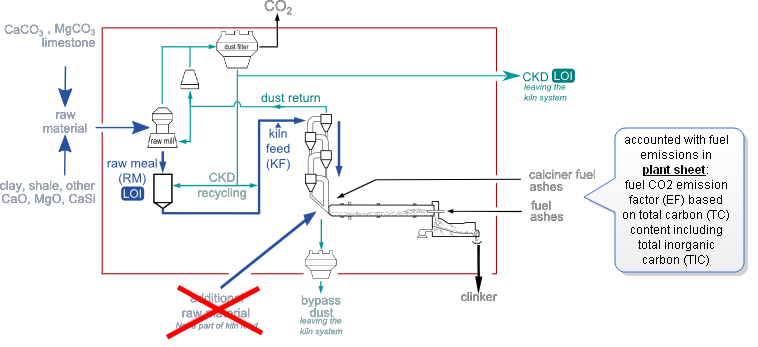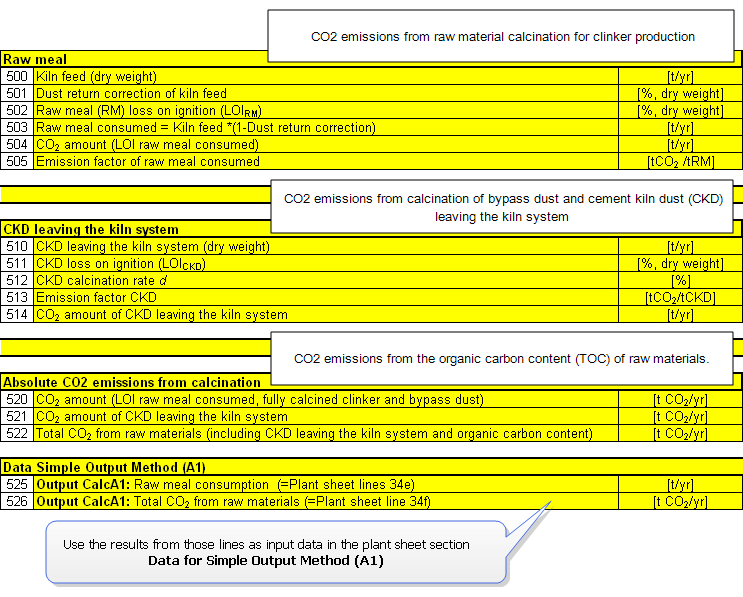Simple Input Method (A1) - LOI of Raw Meal
![]() Loss on IgnitionRM, uncalcined). The loss on ignition of the kiln feed (LOIkiln feed) can be used instead of LOIRM, as long as the dust return is not significantly calcined (degree of calcination: d<5%) and contributes with less than 20% to the amount of kiln feed.
Loss on IgnitionRM, uncalcined). The loss on ignition of the kiln feed (LOIkiln feed) can be used instead of LOIRM, as long as the dust return is not significantly calcined (degree of calcination: d<5%) and contributes with less than 20% to the amount of kiln feed.
Furthermore, the simple input method (A1) accounts for CO2 emissions from the calcination of CKD and bypass dust leaving the kiln system. For bypass dust complete calcination is assumed and no LOI analysis is required.
CO2 emissions from the organic carbon content (TOC) of raw materials are partially included by using the LOI of raw meal as the principle parameter. However, a separate analysis and determination of CO2 emissions from the TOC will be required for raw materials with high TOC content. This could be necessary, for example, if a plant consumes substantial volumes of shale or fly ash high in TOC content as raw materials entering the kiln.
The simple input method (A1) does not account for additional raw materials, which are not included in the kiln feed. If these are relevant for the completeness of the emission inventory, the detailed input method (A2) should be used.
Please also see the Protocol Guidance Document (Chapters, 3.2 and 3.3; Appendix A3).
Figure 3: Diagram of the simple input method (A1)


To calculate CO2 emissions from the calcination of raw materials by using this method:
-
line500 to line504 calculate the CO2 emissions from the calcination of raw meal (RM
 Raw meal) consumed based on the loss on ignition of the raw meal (LOIRM). The determination is based on the amount of raw meal consumed, i.e. the measured amount of kiln feed corrected for dust return, in order to prevent double counting of the recycled part of the kiln feed. For line501 please also see the additional information on Determination of dust return correction regarding Input Methods (A1) and (A2).
Raw meal) consumed based on the loss on ignition of the raw meal (LOIRM). The determination is based on the amount of raw meal consumed, i.e. the measured amount of kiln feed corrected for dust return, in order to prevent double counting of the recycled part of the kiln feed. For line501 please also see the additional information on Determination of dust return correction regarding Input Methods (A1) and (A2). - Lines 510 to 514: The simple input method (A1) accounts for CO2 emissions from bypass dust leaving the kiln system by assuming its complete calcination.
- Lines 520 to 522 determine the total CO2 emissions from the calcination of raw materials.
Use the results in lines525 and line526 as input data in the plant sheet section Data for Simple Output Method (A1).
Please note:
- Please note that the total inorganic carbon (TIC) in fuel ash, like carbonates, is already accounted for as fuel CO2 emissions based on fuel CO2 emission factors (EF) determined from the total carbon (TC) content.
-
Residual humidity and the organic carbon content (TOC) of the raw meal consumed are part of the LOI of the raw meal and accounted for as CO2 emissions.
-
If LOIkiln feed is used as the principle parameter, the relative difference between LOIRM and LOIkiln feed should be < 1% and the degree of calcination in the dust return from the pre-heater should not exceed 5%. This is normally the case for the dry process with cyclone pre-heaters.
Calculation Details
The calculations of CO2 emissions from raw meal are based on the following equation:
Equation 1: Total CO2 from raw materials (method A1)

with:
- CO2 from raw materials [t CO2/yr] = plant sheet line039: Total CO2 from raw materials
- Kiln Feed = Kiln feed in t/yr
- Dust Return Correction = Dust return correction in (%) of the kiln feed
- LOIRM = Loss on ignition of raw meal in %
- CKD leaving kiln system = CKD leaving the kiln system in t/yr
- EFCKD = Emission factor of CKD leaving the kiln system in t CO2/tCKD
Please note that the parameter CKD here refers only to the amount of CKD leaving the kiln system (IPCC: "discarded kiln dust"). The corresponding CO2 emission factor is determined as described in the Protocol Guidance Document, Section 3.3, in reference to Equation 1 and 2, whereby the fractions of carbonate CO2 of raw meal (fCO2RM) and of CKD leaving the kiln system (fCO2CKD) are estimated from analyses of the loss on ignition (LOIRM and LOICKD respectively).
Equation 2: CO2 emission factor for CKD (Protocol Guidance Document, Section 3.3, Equation 1 expressed for method A1)

with:
- EFCKD = Emission factor of CKD leaving the kiln system in t CO2/tCKD
- LOIRM = Loss on ignition of raw meal in %
- d = Degree of calcination
Equation 3: Degree of calcination of CKD leaving the kiln system (Protocol Guidance Document, Section 3.3, Equation 2 expressed for method A1)

with:
- LOICKD = Loss on ignition for CKD in %
- LOIRM = Loss on ignition of raw meal in %
Note: The total inorganic carbon (TIC![]() Total inorganic carbon) in fuel ash originating from carbonates is already accounted for as fuel CO2 emissions based on fuel CO2 emission factors (EF) determined from the total carbon (TC) content.
Total inorganic carbon) in fuel ash originating from carbonates is already accounted for as fuel CO2 emissions based on fuel CO2 emission factors (EF) determined from the total carbon (TC) content.
Where to put the results from the calcination sheet
Please see task Integrate the results of the Calcination sheet into the Plant sheet for further information on how to transfer the results from the output line(s) of your calculation from a calcination sheet into the corresponding Plant sheet.
Please note that the calcination sheet(s) will not be checked by the automatic validation tool.